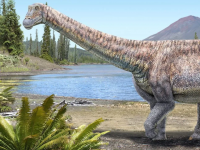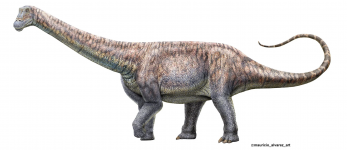Remains of plant-eating dinosaur found in Chile amid world's driest desert
Author of the article:Reuters
Reuters
Fabian Cambero
Publishing date:Apr 19, 2021 • 5 hours ago • 1 minute read • Join the conversation
An artist's impression of a plant-eating dinosaur whose remains scientists discovered in the Atacama Desert in Chile.
An artist's impression of a plant-eating dinosaur whose remains scientists discovered in the Atacama Desert in Chile. PHOTO BY MUSEO NACIONAL DE HISTORIA NATURAL /Handout via REUTERS
Article content
SANTIAGO — Scientists in Chile’s parched Atacama desert, the world’s driest, have discovered the remains of a previously unknown species of dinosaur that millions of years ago lived among lush greenery in what is now a moonscape of rock and sand.
A team led by Chilean geologist Carlos Arevalo unearthed the remains of Arackar licanantay, which means “Atacama bones” in the Kunza language, 75 kilometres south of the desert city of Copiapo. The so-called titanosaur had a small head and long neck and tail, as well as an unusually flat back compared with others like it.
Recent paleontological studies suggest Arackar lived amid flowering plants, ferns and palm trees during the Cretaceous period 66-80 million years ago. Parts of the Atacama today, by contrast, have gone without rain for one hundred years and support little plant or animal life.
The discovery of a titanosaur on the west side of South America’s Andes Mountains is rare, though several species have been found in Argentina and Brazil, further east.
An artist’s impression of a plant-eating dinosaur whose remains scientists discovered in the Atacama Desert in Chile.
An artist’s impression of a plant-eating dinosaur whose remains scientists discovered in the Atacama Desert in Chile. PHOTO BY MUSEO NACIONAL DE HISTORIA NATURAL /Handout via REUTERS
The dinosaur’s remains were first discovered in the 1990s and were described by the scientists in the journal Cretaceous Research.
Arackar also appears smaller in size compared with some other titanosaurs. The Argentinosaurus, discovered on the east side of the Andes in neighbouring Argentina, was more than four times as long, scientists say.
The dinosaur’s remains will eventually be exhibited in Chile’s Museum of Natural History, though that is currently closed due to coronavirus restrictions.



 torontosun.com
torontosun.com
Author of the article:Reuters
Reuters
Fabian Cambero
Publishing date:Apr 19, 2021 • 5 hours ago • 1 minute read • Join the conversation
An artist's impression of a plant-eating dinosaur whose remains scientists discovered in the Atacama Desert in Chile.
An artist's impression of a plant-eating dinosaur whose remains scientists discovered in the Atacama Desert in Chile. PHOTO BY MUSEO NACIONAL DE HISTORIA NATURAL /Handout via REUTERS
Article content
SANTIAGO — Scientists in Chile’s parched Atacama desert, the world’s driest, have discovered the remains of a previously unknown species of dinosaur that millions of years ago lived among lush greenery in what is now a moonscape of rock and sand.
A team led by Chilean geologist Carlos Arevalo unearthed the remains of Arackar licanantay, which means “Atacama bones” in the Kunza language, 75 kilometres south of the desert city of Copiapo. The so-called titanosaur had a small head and long neck and tail, as well as an unusually flat back compared with others like it.
Recent paleontological studies suggest Arackar lived amid flowering plants, ferns and palm trees during the Cretaceous period 66-80 million years ago. Parts of the Atacama today, by contrast, have gone without rain for one hundred years and support little plant or animal life.
The discovery of a titanosaur on the west side of South America’s Andes Mountains is rare, though several species have been found in Argentina and Brazil, further east.
An artist’s impression of a plant-eating dinosaur whose remains scientists discovered in the Atacama Desert in Chile.
An artist’s impression of a plant-eating dinosaur whose remains scientists discovered in the Atacama Desert in Chile. PHOTO BY MUSEO NACIONAL DE HISTORIA NATURAL /Handout via REUTERS
The dinosaur’s remains were first discovered in the 1990s and were described by the scientists in the journal Cretaceous Research.
Arackar also appears smaller in size compared with some other titanosaurs. The Argentinosaurus, discovered on the east side of the Andes in neighbouring Argentina, was more than four times as long, scientists say.
The dinosaur’s remains will eventually be exhibited in Chile’s Museum of Natural History, though that is currently closed due to coronavirus restrictions.



Remains of plant-eating dinosaur found in Chile amid world's driest desert
SANTIAGO — Scientists in Chile’s parched Atacama desert, the world’s driest, have discovered the remains of a previously unknown species of dinosaur that millions o…